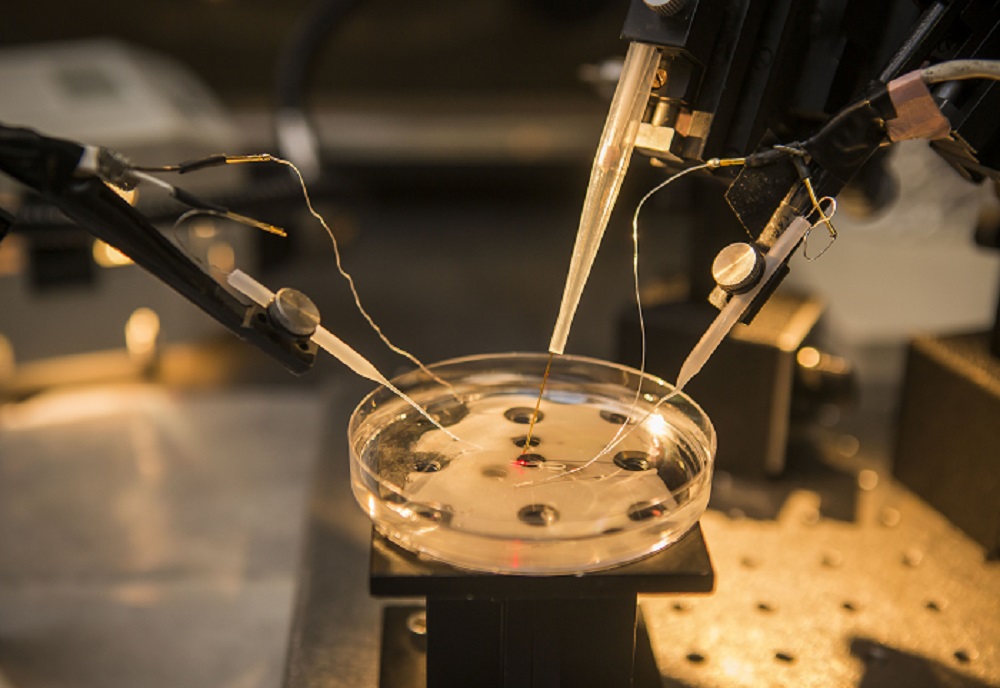Infrared Neural Modulation
Our labs have pioneered the application of pulsed infrared lasers for the activation and inactivtaion of neural tissues in a damage-free, artifact-free, contact-free way. Based on this discovery, we have numerous ongoing projects that are focused on what we call infrared neural modulation (INM). We refer to the activation of neural tissue as infrared neural stimulation (INS) and the inactivation of neural tissue infrared neural inhibition (INI). These projects span from the fundamental discovery of what makes INM work to the clinical translation of this technique in human nerves in vivo.
Infrared Neural Stimulation
Biophysical Mechanism of INS
 Research is being performed to identify the biophysical mechanism of INS. Our lab has shown that INS is mediated through a photothermal mechanism requiring a transient spatial and temporal thermal gradient to generate a neural response. How infrared radiation is transduced into an action potential still remains unclear. Follow-up studies have demonstrated that infrared radiation transiently alters the capacitance of the cell through induced conformational changes in the lipid bilayer. Direct experimental proof for these findings, however, is lacking. Our lab utilizes nonlinear microscopies to observe lipid membrane dynamics during INS to uncover this mechanism. For more information click
here
.
Research is being performed to identify the biophysical mechanism of INS. Our lab has shown that INS is mediated through a photothermal mechanism requiring a transient spatial and temporal thermal gradient to generate a neural response. How infrared radiation is transduced into an action potential still remains unclear. Follow-up studies have demonstrated that infrared radiation transiently alters the capacitance of the cell through induced conformational changes in the lipid bilayer. Direct experimental proof for these findings, however, is lacking. Our lab utilizes nonlinear microscopies to observe lipid membrane dynamics during INS to uncover this mechanism. For more information click
here
.
INS in the Peripheral Nervous System

Our lab was the first to demonstrate the ability of infrared pulses to excite neural tissue in the sciatic nerve of rats. Since then, infrared light has been shown to activate a variety of peripheral nerves in vivo including both motor and sensory pathways. After initial safety and efficacy demonstrations of INS, it has been applied to the cochlea, vestibular system, cavernous nerves of the prostate, facial, and the heart. Our lab has also leveraged the spatial resolution of INS to outperform electrical stimulation by more precisely activating dorsal roots in patients undergoing selective dorsal root rhizotomy. Current efforts in our lab are directed toward the optimization of INS parameters as well as the clinical translation of INS. For more information click here.
INS in the Central Nervous System
While INS is well characterized for the peripheral nervous system, the translation to the central nervous system (CNS) presents a new set of challenges that require us to consider different anatomy, multiple cell types, and the physiology associated with structures in the CNS. Our research in the CNS has focused on rat brain slices, in vivo rat brain, and in vivo non-human primate brain to demonstrate the efficacy, mechanisms, and research applications of INS.This research has shown that infrared pulses can modulate neural activity by either inducing an excitatory or inhibitory response. Studies in the rat brain revealed that the INS-induced response is partially mediated through astrocytes. Continuing studies are investigating infrared modulation of glial cells in addition to using INS to alter neural activity during seizures. For more information click here.
Hybrid Electrical-Optical Stimulation
 While INS provides an artifact-free, contact-free and spatially selective alternative to electrical methods, it can be limited by a narrow range of radiant exposures (J/cm2) that are both safe and effective for neural activation. To lower the optical energy requirements, we have combined INS with subthreshold electrical stimulus to reduce the stimulation threshold radiant exposures of INS while maintaining the spatial selectivity. We have named this technique hybrid neural stimulation. In addition to improving the safety of INS. the combined interaction of electrical and optical stimulation has uncovered a difference in mechanism(s) responsible for the two modalities. For more information click here.
While INS provides an artifact-free, contact-free and spatially selective alternative to electrical methods, it can be limited by a narrow range of radiant exposures (J/cm2) that are both safe and effective for neural activation. To lower the optical energy requirements, we have combined INS with subthreshold electrical stimulus to reduce the stimulation threshold radiant exposures of INS while maintaining the spatial selectivity. We have named this technique hybrid neural stimulation. In addition to improving the safety of INS. the combined interaction of electrical and optical stimulation has uncovered a difference in mechanism(s) responsible for the two modalities. For more information click here.
Current Projects in INS
- Biophysical mechanism of INS
- Effects of INS on glial cells
- Clinical translation of INS
- Computational modeling of INS
Infrared Neural Inhibition

Current Projects in INI
- Optimization of INI parameters
- Computational modeling of INI
